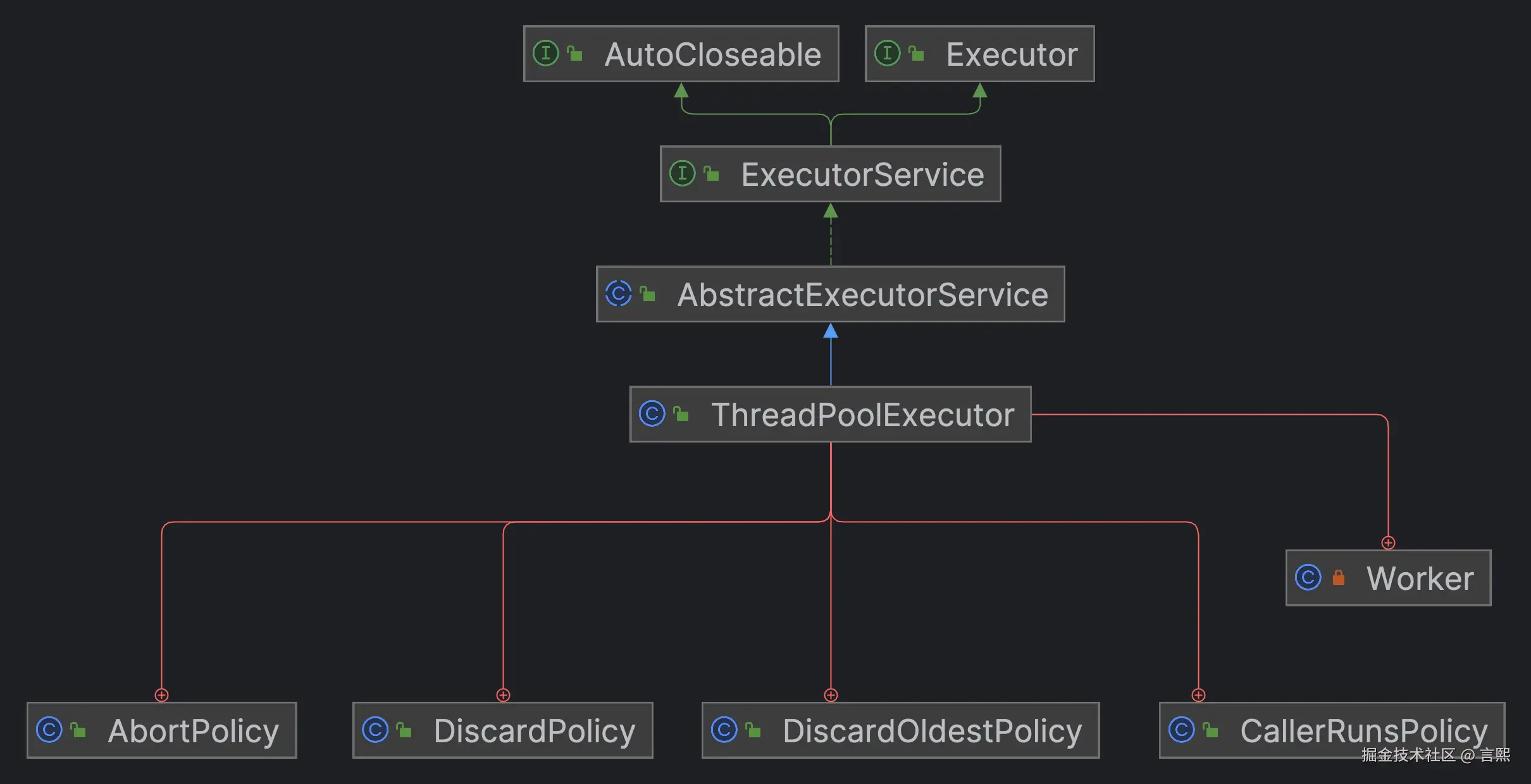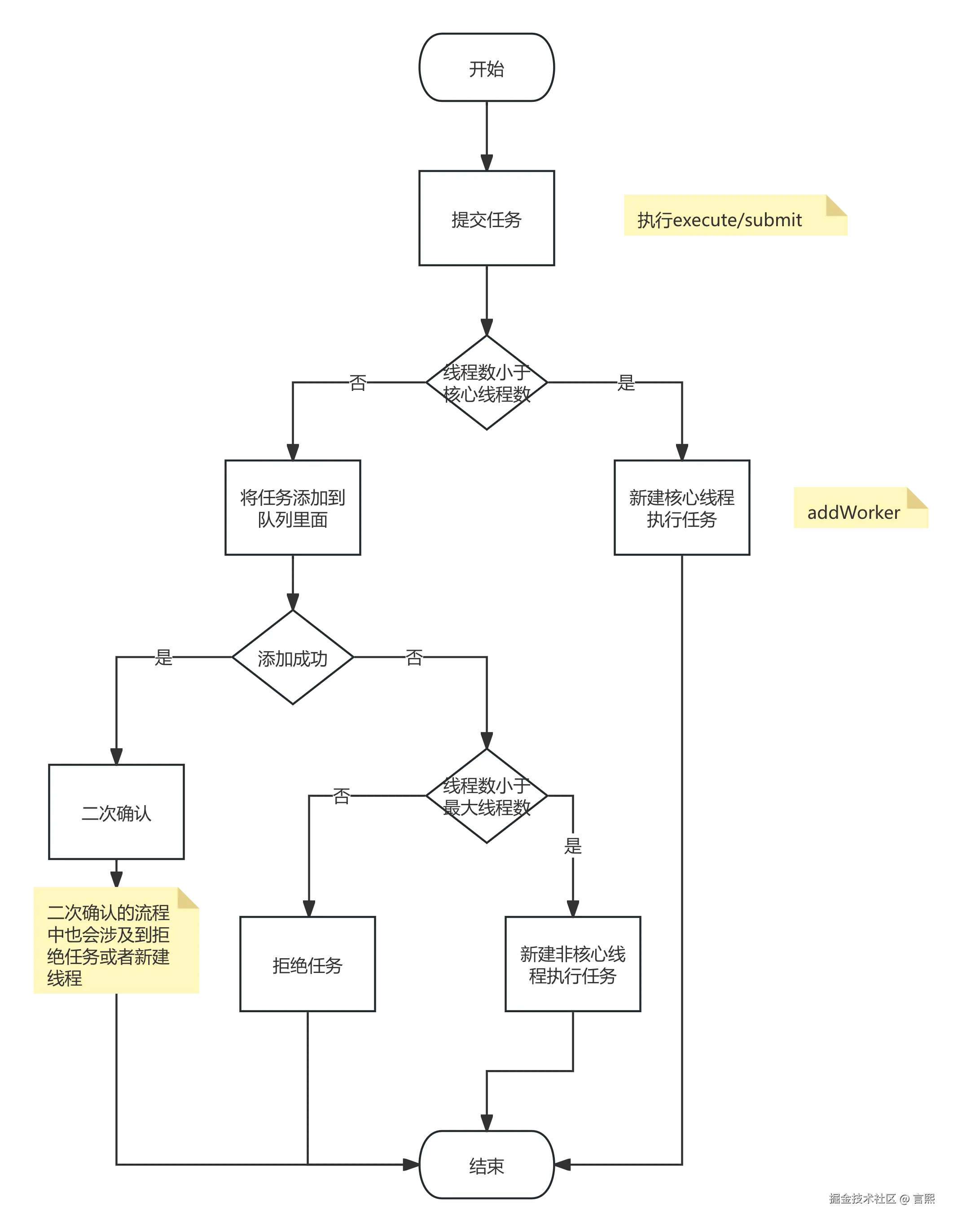本文源码基于JDK21
简介
 线程的创建和销毁都比较耗费资源,所以我们可以通过池化技术去重复利用创建好的线程,在Java中,
线程的创建和销毁都比较耗费资源,所以我们可以通过池化技术去重复利用创建好的线程,在Java中,ThreadPoolExecutor就是池化技术的一种具体实现。
核心流程
 我们可以通过
我们可以通过ThreadPoolExecutor的构造方法去了解它的核心参数有哪些。
java
public ThreadPoolExecutor(int corePoolSize,
int maximumPoolSize,
long keepAliveTime,
TimeUnit unit,
BlockingQueue<Runnable> workQueue,
ThreadFactory threadFactory,
RejectedExecutionHandler handler) {
if (corePoolSize < 0 ||
maximumPoolSize <= 0 ||
maximumPoolSize < corePoolSize ||
keepAliveTime < 0)
throw new IllegalArgumentException();
if (workQueue == null || threadFactory == null || handler == null)
throw new NullPointerException();
this.corePoolSize = corePoolSize;
this.maximumPoolSize = maximumPoolSize;
this.workQueue = workQueue;
this.keepAliveTime = unit.toNanos(keepAliveTime);
this.threadFactory = threadFactory;
this.handler = handler;
String name = Objects.toIdentityString(this);
this.container = SharedThreadContainer.create(name);
}各个参数的说明如下:
corePoolSize:核心线程数量maximumPoolSize:最大线程数量keepAliveTime:线程的存活时间unit:存活时间单位workQueue:等待队列threadFactory:创建线程的工厂handler:任务拒绝策略
源码解析
接下来,从提交任务开始,通过源码去了解ThreadPoolExecutor的运行原理。
提交任务
ThreadPoolExecutor有两种提交任务的方式:
submit:可以获取任务的返回值execute:无返回值
java
public <T> Future<T> submit(Callable<T> task) {
if (task == null) throw new NullPointerException();
RunnableFuture<T> ftask = newTaskFor(task);
execute(ftask);
return ftask;
}
Java
public void execute(Runnable command) {
if (command == null)
throw new NullPointerException();
int c = ctl.get();
// 1、运行线程数量小于核心线程数,就新建线程
// 新建线程的逻辑在addWorker方法中
if (workerCountOf(c) < corePoolSize) {
if (addWorker(command, true))
return;
c = ctl.get();
}
// 2、核心线程数已满,将任务添加到队列里面
// 会先判断线程是否还在运行,这里会有个recheck
if (isRunning(c) && workQueue.offer(command)) {
int recheck = ctl.get();
if (! isRunning(recheck) && remove(command))
reject(command);
else if (workerCountOf(recheck) == 0)
addWorker(null, false);
}
// 3、如果线程数量小于最大线程数,添加非核心线程执行任务
else if (!addWorker(command, false))
// 4、线程数量大于最大线程数,拒绝任务
reject(command);
}addWorker
java
private boolean addWorker(Runnable firstTask, boolean core) {
// 1、通过cas操作去修改线程数量
retry:
for (int c = ctl.get();;) {
// Check if queue empty only if necessary.
if (runStateAtLeast(c, SHUTDOWN)
&& (runStateAtLeast(c, STOP)
|| firstTask != null
|| workQueue.isEmpty()))
return false;
for (;;) {
if (workerCountOf(c)
>= ((core ? corePoolSize : maximumPoolSize) & COUNT_MASK))
return false;
if (compareAndIncrementWorkerCount(c))
break retry;
c = ctl.get(); // Re-read ctl
if (runStateAtLeast(c, SHUTDOWN))
continue retry;
// else CAS failed due to workerCount change; retry inner loop
}
}
boolean workerStarted = false;
boolean workerAdded = false;
Worker w = null;
try {
// 2、新建线程去执行任务
w = new Worker(firstTask);
final Thread t = w.thread;
if (t != null) {
final ReentrantLock mainLock = this.mainLock;
mainLock.lock();
try {
// Recheck while holding lock.
// Back out on ThreadFactory failure or if
// shut down before lock acquired.
int c = ctl.get();
if (isRunning(c) ||
(runStateLessThan(c, STOP) && firstTask == null)) {
if (t.getState() != Thread.State.NEW)
throw new IllegalThreadStateException();
workers.add(w);
workerAdded = true;
int s = workers.size();
if (s > largestPoolSize)
largestPoolSize = s;
}
} finally {
mainLock.unlock();
}
if (workerAdded) {
// 3、启动线程
container.start(t);
workerStarted = true;
}
}
} finally {
if (! workerStarted)
addWorkerFailed(w);
}
return workerStarted;
}线程创建在第2步,线程的启动入口在第3步。Worker核心代码如下:
java
private final class Worker extends AbstractQueuedSynchronizer implements Runnable {
final Thread thread;
Runnable firstTask;
Worker(Runnable firstTask) {
setState(-1); // inhibit interrupts until runWorker
this.firstTask = firstTask;
this.thread = getThreadFactory().newThread(this);
}
public void run() {
runWorker(this);
}
}Worker实现了Runnable接口,在其构造方法内新建了线程,并把自己作为新建线程的参数,当线程启动的时候,就会执行Worker的run方法。接下来看看ThreadPoolExecutor#runWorkder方法:
java
final void runWorker(Worker w) {
Thread wt = Thread.currentThread();
Runnable task = w.firstTask;
w.firstTask = null;
w.unlock(); // allow interrupts
// 标志该线程是正常完成任务还是异常终止了
boolean completedAbruptly = true;
try {
// 循环从队列里面拉取任务并执行
while (task != null || (task = getTask()) != null) {
w.lock();
if ((runStateAtLeast(ctl.get(), STOP) ||
(Thread.interrupted() &&
runStateAtLeast(ctl.get(), STOP))) &&
!wt.isInterrupted())
wt.interrupt();
try {
beforeExecute(wt, task);
try {
task.run();
afterExecute(task, null);
} catch (Throwable ex) {
afterExecute(task, ex);
throw ex;
}
} finally {
task = null;
w.completedTasks++;
w.unlock();
}
}
completedAbruptly = false;
} finally {
processWorkerExit(w, completedAbruptly);
}
}核心其实就是一直循环去执行任务,任务完成之后就从队列里面拉取任务;而且还提供了beforeExecute和afterExecute两个钩子方法,我们可以利用这两个方法在任务执行前/后去执行我们想要执行的逻辑。
需要注意getTask方法,当它返回null的时候,循环会终止,这时会走到processWorkerExit方法。
java
private Runnable getTask() {
boolean timedOut = false; // Did the last poll() time out?
for (;;) {
int c = ctl.get();
// Check if queue empty only if necessary.
if (runStateAtLeast(c, SHUTDOWN)
&& (runStateAtLeast(c, STOP) || workQueue.isEmpty())) {
decrementWorkerCount();
return null;
}
int wc = workerCountOf(c);
// Are workers subject to culling?
// 只有运行线程数大于核心线程数或者允许核心线程超时
boolean timed = allowCoreThreadTimeOut || wc > corePoolSize;
if ((wc > maximumPoolSize || (timed && timedOut))
&& (wc > 1 || workQueue.isEmpty())) {
if (compareAndDecrementWorkerCount(c))
return null;
continue;
}
try {
Runnable r = timed ?
workQueue.poll(keepAliveTime, TimeUnit.NANOSECONDS) :
workQueue.take();
if (r != null)
return r;
timedOut = true;
} catch (InterruptedException retry) {
timedOut = false;
}
}
}可以看到,只有当运行线程数量大于核心线程数或者允许核心线程超时,且从队列中获取任务超时时,getTask才会返回null,接下来看看ThreadPoolExecutor#processWorkerExit方法。
java
private void processWorkerExit(Worker w, boolean completedAbruptly) {
if (completedAbruptly) // If abrupt, then workerCount wasn't adjusted
decrementWorkerCount();
final ReentrantLock mainLock = this.mainLock;
mainLock.lock();
try {
completedTaskCount += w.completedTasks;
// 1、移除worker
workers.remove(w);
} finally {
mainLock.unlock();
}
tryTerminate();
int c = ctl.get();
if (runStateLessThan(c, STOP)) {
if (!completedAbruptly) {
int min = allowCoreThreadTimeOut ? 0 : corePoolSize;
if (min == 0 && !workQueue.isEmpty())
min = 1;
if (workerCountOf(c) >= min)
return; // replacement not needed
}
addWorker(null, false);
}
}当worker被移除,在gc的时候该线程就会被回收,通过这种方式来完成对线程的销毁。
拒绝策略
默认有四种拒绝策略,也可以自己实现RejectedExecutionHandler接口去定义自己想要的拒绝策略。
CallerRunsPolicy:提交任务的线程去执行该任务
java
public void rejectedExecution(Runnable r, ThreadPoolExecutor e) {
if (!e.isShutdown()) {
r.run();
}
}AbortPolicy:抛出RejectedExecutionException异常
java
public void rejectedExecution(Runnable r, ThreadPoolExecutor e) {
throw new RejectedExecutionException("Task " + r.toString()
" rejected from " +
e.toString());
}DiscardPolicy:丢弃任务,不做任何处理
java
public void rejectedExecution(Runnable r, ThreadPoolExecutor e) {
}DiscardOldestPolicy:丢弃最老的任务,然后再次提交本次任务
java
public void rejectedExecution(Runnable r, ThreadPoolExecutor e) {
if (!e.isShutdown()) {
e.getQueue().poll();
e.execute(r);
}
}